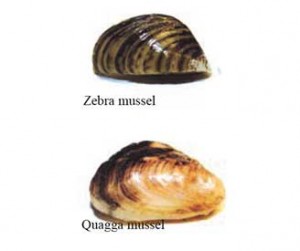Zebra and Quagga Mussels
Dreissena polymorpha, Dreissena rostiformis
Description
Small freshwater mussel up to 1.5 in. Zebra is striped with zigzagged yellowish striped patterns, and flat side that can stand up on edge. Quagga is usually pale and may have colored bands or bars, sometimes with a few stripes – no flat edge to stand on.
Habitat
Found in freshwater lakes, ponds and slow-moving or sluggish streams/rivers. Attaches to hard surfaces such as rocks, docks, cement, wood, debris, and vegetation. Quaggas can bury into soft sediments.
Zebra mussels have been found on moss balls or in their containers in 41 states, including Nebraska, and also found in 9 provinces & territories in Canada.

 Photos by: Idaho State Department of Agriculture
Photos by: Idaho State Department of Agriculture Learn more about how to dispose of moss balls:
Location in Nebraska
There are 3 waterbodies infested with zebra mussels in Nebraska. The Missouri River, the entire length of the river in Nebraska (2016), Lewis and Clark Lake near Yankton, SD (2015), Offutt Air Force Base Lake in Bellevue, NE (2014).
Watch Presentation on Watercraft Inspections and Outreach Initatives in Nebraska here and here.
A zebra mussel eradication effort occured at Glenn Cunningham lake in Omaha, NE in late 2018 to freeze and kill a newly established zebra mussel colony after adults were confirmed in July 2018. The waterbody was renovated reopened on August 5, 2021. Regular monitoring for zebra mussels will occur. Nebraska has 4 waterbodies designated as positive for zebra mussels including, including Glenn Cunningham (per the Western Regional Panel on Aquatic Nuisance Species guidelines). A positive waterbody can be delisted after 5 years of negative sampling, meaning zebra mussel larvae or adults were not found.
Carter Lake in Omaha, NE (2020) is Nebraska's only suspect waterbody. A suspect waterbody is a waterbody that has had a single water sample contain zebra mussel larvae. No supsequent water samples or visual sampling has found zebra mussel larvae or adults. A suspect waterbody can be delisted after 3 consecutive years of frequent sampling and no dditional finding of zebra mussel larvae or adult.
Quagga mussels have never been found in Nebraska. Download current national range map.

Offutt Air Force Base lake was treated with Copper Sulfate to kill zebra mussels in 2008 and 2009. The zebra mussels returned and a large infestation was found in early 2014. Motorboats are not allowed on the lake but non-motorized watercrafts are allowed and motorboats can be rented at the boat house at the lake. Download more information here: Offutt Lake Information.
Zebra mussel larvae (veligers) were found at Lake Zorinsky in Omaha, NE in May 2016 after a fisherman reported having a zebra mussel on a fishing line (which was never verified by officials). A single water sample taken in May 2016 had veligers but since that time no other water sample has contained veligers and no adults have been found at the lake since it was drained in 2011. This waterbody was delisted in May 2019 and is now a negative waterbody for zebra mussels. The lake had been drawn down 17 feet to freeze out a zebra mussel population in the winter of 2010/2011. The lake was then reopened and monitored annually.
Gavin’s Point Dam & the Missouri River: A single adult mussel was found in November 2014 on a dock and Midway Marina in South Dakota. Lewis and Clark Lake, near Yankton, NE was found to have a zebra mussel infestation in August 2015 after mussels were found on the underside of floating boat lifts and moored watercrafts. The infestation was found to occur downstream from the Gavin’s Point dam in the entire length of the Missouri River on the Nebraska boarder. Any one that launches their watercraft in the Missouri River along the Nebraska boarder should Clean, Drain and Dry their watercraft for at least 5 days between use to reduce the chance of transporting zebra mussels.
Several of Nebraska’s surrounding states have zebra and quagga mussels which threaten our waterbodies. The Nebraksa Invasive Species Program & Nebraska Game and Parks Commission employs seasonal technicians to conduct watercraft inspections and outreach. The Nebraksa Invasive Species Program conducts outreach and education year round.
To learn more about zebra and quagga mussel treatment efforts here.
Pathway of Introduction and Spread
First ntroduced into the U.S. via ballast water discharge from commercial shipping vessels in the Great Lakes in the late 1980's. Larval stage and adults can spread between waters when transported in bait buckets, live wells, bilge water or attached to hull/motors/trailers and other equipment-Learn how to prevent their spread. Adult mussels can survive ~3 weeks out of water depending on humidity and air temperature. Zebra and quagga mussel larvae and adults can survive out of water for up to 30 days making them easily transmitted in boat compartment and on their exterior. Clean, Drain and Dry boats before launching in another waterbody. Learn about zebra and quagga mussel control methods here and control efforts here.
Impacts
Forms dense colonies and filters large quantities of plankton from water, decreasing the food supply for native species. Increases water clarity causing increases in unwanted vegetation. Pollute swimming areas with sharp shells. Clog water intake pipes for power and treatment facilities, irrigation pipes, etc.
Douglas Facey, Michigan Sea Grant
U.S. Bureau of Reclamation






